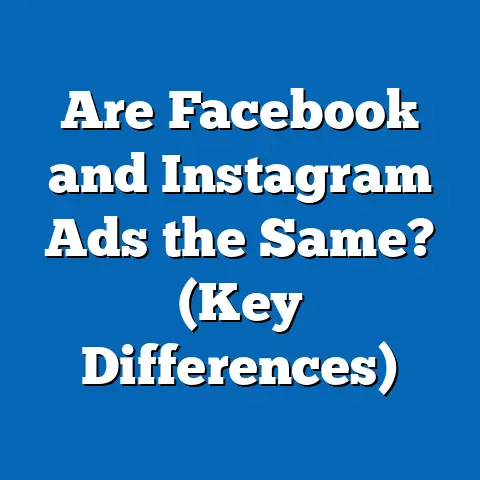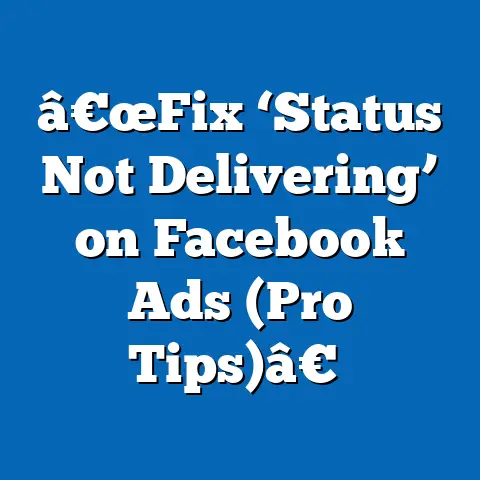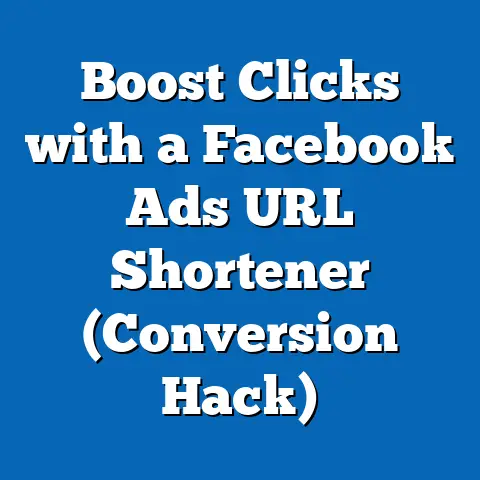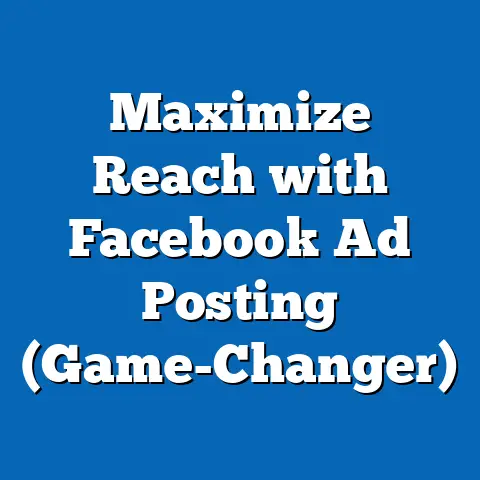Boost iOS Facebook Ads for Maximum Impact (Pro Tips Inside)
Boost iOS Facebook Ads for Maximum Impact: Pro Tips Inside
“Advertising on platforms like Facebook has become a cornerstone of modern marketing, especially for iOS apps, where user acquisition costs are rising and privacy changes are reshaping the landscape,” says Sarah Johnson, a digital marketing expert with over a decade of experience in mobile app advertising. Her insight underscores a critical reality: as the digital ecosystem evolves, particularly with Apple’s stringent privacy policies like App Tracking Transparency (ATT), marketers must adapt their strategies to maximize the impact of iOS Facebook ads. This article delves into the intricacies of boosting iOS Facebook ads, exploring key defining characteristics of effective campaigns, the historical context of mobile advertising, and the broader societal implications of these shifts, while offering actionable pro tips for success.
Introduction: Navigating the iOS Advertising Landscape
The world of digital advertising has undergone seismic shifts in recent years, with iOS platforms at the epicenter of change. Apple’s introduction of ATT in 2021, which requires apps to obtain explicit user consent for tracking, has significantly disrupted traditional advertising models on platforms like Facebook. This policy, coupled with the competitive nature of the iOS app market, has made optimizing ad campaigns more complex than ever.
For businesses and marketers, understanding how to navigate these challenges is crucial. This article provides a comprehensive analysis of boosting iOS Facebook ads for maximum impact, drawing on data-driven insights, expert opinions, and practical strategies. From understanding the historical evolution of mobile ads to addressing the societal implications of privacy changes, we aim to equip readers with the tools needed to succeed in this dynamic environment.
Defining Characteristics of Effective iOS Facebook Ads
Effective iOS Facebook ads share several core characteristics that distinguish them in a crowded digital marketplace. First, they prioritize creative excellence—compelling visuals, concise copy, and strong calls-to-action (CTAs) are non-negotiable in capturing user attention amidst endless scrolling. Data from Facebook’s own advertising insights suggests that ads with high-quality visuals can achieve up to 40% higher engagement rates.
Second, targeting precision remains critical, even in a post-ATT world. While user-level tracking has been curtailed, marketers can still leverage contextual targeting, lookalike audiences, and broad demographic data to reach relevant users. Finally, successful campaigns are rooted in continuous optimization—using A/B testing, analyzing performance metrics, and iterating based on real-time data ensures ads remain effective over time.
It’s also worth noting the diversity in ad formats available on Facebook, from carousel ads to video ads and stories. Each format offers unique opportunities for engagement, but their effectiveness often depends on the specific goals of an iOS app campaign, whether it’s driving installs, in-app purchases, or brand awareness. Understanding these characteristics is the foundation for crafting ads that resonate with iOS users.
Historical Context: The Evolution of Mobile Advertising
To fully appreciate the current state of iOS Facebook ads, it’s essential to trace the historical trajectory of mobile advertising. The early 2000s marked the dawn of mobile ads with the rise of SMS-based marketing, but it wasn’t until the launch of the iPhone in 2007 that mobile advertising truly took off. Apple’s App Store, introduced in 2008, created a new ecosystem for app developers and advertisers to reach millions of users.
Facebook entered the mobile ad space in 2012 with the introduction of mobile newsfeed ads, capitalizing on the growing time users spent on their smartphones. By 2016, mobile ads accounted for over 80% of Facebook’s ad revenue, highlighting the platform’s dominance in the space. This period also saw the rise of sophisticated tracking tools, enabling hyper-targeted campaigns based on user behavior and preferences.
However, the landscape shifted dramatically in 2021 with Apple’s ATT framework, a response to growing consumer concerns over data privacy. This policy disrupted the ability of platforms like Facebook to track users across apps and websites, leading to a reported $10 billion loss in ad revenue for Meta in 2022 alone, according to company statements. This historical pivot underscores the need for marketers to adapt to a privacy-first world while still leveraging the power of platforms like Facebook.
Societal Implications: Privacy, Trust, and Digital Culture
The changes in iOS advertising, driven by Apple’s privacy policies, have far-reaching societal implications. At the core is the issue of user trust—surveys conducted by Pew Research in 2022 revealed that 81% of Americans are concerned about how their data is used by companies. Apple’s ATT framework, while controversial among advertisers, has been praised by privacy advocates for empowering users to control their data.
This shift also reflects broader cultural trends toward digital autonomy and transparency. As younger generations, such as Gen Z, grow up in a world where data breaches and privacy scandals are commonplace, their expectations for ethical advertising practices are higher than ever. Marketers must balance the need for effective targeting with respect for user privacy, or risk alienating their audience.
Moreover, the economic impact of these changes cannot be ignored. Small businesses, which rely heavily on affordable, targeted ads to compete with larger players, have been disproportionately affected by the loss of granular tracking data. A 2022 study by the National Bureau of Economic Research found that small businesses saw a 20-30% increase in customer acquisition costs post-ATT. This raises questions about the democratization of digital advertising and whether privacy protections inadvertently favor larger corporations with bigger budgets.
Technological Factors: Adapting to a Post-ATT World
Technologically, the post-ATT era has forced platforms like Facebook to innovate. Meta has invested heavily in machine learning to improve ad delivery without relying on user-level data, introducing tools like Advantage+ campaigns that automate targeting based on broader signals. For iOS marketers, understanding these tools is essential to maximizing ad impact.
Additionally, the rise of on-device processing and aggregated data models, such as Apple’s SKAdNetwork, offers alternative ways to measure campaign performance without compromising user privacy. While these solutions are still evolving, early adopters have reported promising results—Facebook data indicates that SKAdNetwork integrations have helped recover up to 60% of lost attribution data for some advertisers.
However, these technological advancements come with a learning curve. Marketers must invest time and resources to understand new attribution models and adapt their strategies accordingly. Staying ahead of the curve requires a willingness to experiment with emerging tools and platforms while maintaining a focus on user experience.
Economic Factors: Balancing Cost and ROI
Economically, the iOS advertising landscape is marked by rising costs and shifting return on investment (ROI) dynamics. According to AppsFlyer’s 2023 Mobile Marketing Report, the average cost-per-install (CPI) for iOS apps increased by 25% following the rollout of ATT, driven by reduced targeting efficiency. This trend poses challenges for marketers with limited budgets, particularly in competitive categories like gaming and e-commerce.
To counter this, optimizing ad spend is more important than ever. Strategies like focusing on high-value users (those likely to make in-app purchases) and prioritizing retention over acquisition can improve long-term ROI. Additionally, diversifying ad spend across other platforms, such as TikTok or Google, can mitigate the risks of over-reliance on Facebook in the iOS space.
Economic pressures also highlight the importance of creative optimization. High-performing ads can reduce CPI by engaging users more effectively, stretching limited budgets further. Marketers who master the art of balancing cost and impact will be best positioned to thrive in this challenging environment.
Social and Cultural Factors: Engaging iOS Users
Socially and culturally, iOS users represent a unique demographic that marketers must understand to craft resonant campaigns. iOS users tend to skew toward higher income brackets and are often early adopters of technology, according to a 2022 Statista report. This demographic is also more likely to value premium experiences, making brand storytelling and polished creatives particularly effective.
Cultural trends, such as the growing emphasis on sustainability and social responsibility, also influence how iOS users engage with ads. Campaigns that align with these values—such as highlighting eco-friendly practices or supporting social causes—can build stronger connections with audiences. For example, a 2023 Nielsen study found that 73% of Gen Z and Millennial users are more likely to engage with brands that demonstrate social impact.
However, cultural nuances vary widely across regions and demographics within the iOS user base. A one-size-fits-all approach to ad creative or messaging is unlikely to succeed. Tailoring campaigns to local languages, cultural references, and user preferences is key to maximizing engagement.
Pro Tips for Boosting iOS Facebook Ads
With the foundational context in mind, let’s dive into actionable strategies for boosting iOS Facebook ads. These pro tips, grounded in industry best practices and data, are designed to help marketers achieve maximum impact.
1. Leverage Creative Testing for Maximum Engagement
Creative elements are the heart of any successful ad campaign. Test multiple variations of visuals, headlines, and CTAs to identify what resonates most with your audience. Use Facebook’s split testing feature to compare performance and iterate based on results—data shows that campaigns with regular creative refreshes can see a 15-20% uplift in click-through rates (CTR).
Focus on video content, which often outperforms static images. Short, engaging videos (under 15 seconds) that highlight your app’s key features or benefits can drive higher conversions. Ensure your creatives are mobile-optimized, with clear text and visuals that stand out on smaller screens.
2. Optimize for Broad Targeting in a Privacy-First World
With user-level tracking limited, shift your focus to broad targeting strategies. Use interest-based targeting and lookalike audiences based on existing customer data to reach relevant users. Facebook’s Advantage+ campaigns can also automate audience selection, leveraging machine learning to find high-potential users.
Don’t overlook contextual targeting—place ads in environments where users are already engaged, such as specific Facebook groups or pages. This approach can improve relevance without relying on invasive tracking. Regularly review audience insights to refine your targeting over time.
3. Prioritize App Event Optimization (AEO) and Value Optimization (VO)
For iOS campaigns, optimizing for specific in-app events (like purchases or registrations) through App Event Optimization can improve ad delivery to high-value users. Similarly, Value Optimization focuses on users likely to generate higher revenue, maximizing ROI.
Work with your development team to ensure proper event tracking setup via SKAdNetwork or other attribution tools. Monitor performance metrics like cost-per-event to ensure your campaigns are driving meaningful outcomes. This data-driven approach is critical in a landscape where traditional tracking is limited.
4. Experiment with Ad Formats and Placements
Facebook offers a variety of ad formats and placements—don’t limit yourself to a single approach. Test carousel ads to showcase multiple app features, or use stories ads for immersive, full-screen experiences. Instant Experience ads can also provide interactive content that drives deeper engagement.
Placement optimization is equally important. While newsfeed ads remain popular, consider less competitive placements like Marketplace or Audience Network to reduce costs. Use Facebook’s automatic placements feature initially to identify high-performing channels, then refine manually for better control.
5. Focus on Retention and Re-Engagement Campaigns
Acquiring new users is only half the battle—retaining them is just as important. Use Facebook’s re-engagement campaigns to target users who have installed your app but haven’t taken key actions. Personalized ads offering incentives (like discounts or bonus content) can boost retention rates.
Segment your audience based on behavior, such as lapsed users versus active ones, to tailor messaging effectively. According to a 2023 Adjust report, re-engagement campaigns can reduce churn by up to 30% when executed well. Retention-focused strategies ensure long-term value from your ad spend.
6. Stay Agile with Budget Allocation
In the volatile iOS ad space, flexibility is key. Start with smaller budgets to test campaigns, then scale up for high-performing ads. Use Facebook’s Campaign Budget Optimization (CBO) to allocate spend dynamically across ad sets based on performance.
Monitor cost trends closely—rising CPIs may signal audience fatigue or increased competition. Be prepared to pivot to new audiences or platforms if returns diminish. A nimble approach to budgeting can prevent wasted spend and maximize impact.
7. Integrate SKAdNetwork for Attribution Insights
Apple’s SKAdNetwork is a critical tool for measuring iOS campaign performance in a privacy-compliant way. Work with your team to implement SKAdNetwork integration, ensuring accurate tracking of installs and in-app events. Partner with attribution platforms like AppsFlyer or Adjust to simplify the process.
While SKAdNetwork has limitations, such as delayed reporting, it provides valuable insights into campaign effectiveness. Use these insights to refine targeting and creative strategies over time. Staying ahead of attribution challenges is essential for long-term success.
Implications for Businesses and Marketers
The evolving iOS Facebook ad landscape has significant implications across multiple domains. For businesses, the increased cost and complexity of advertising necessitate a stronger focus on efficiency and creativity. Small and medium-sized enterprises (SMEs), in particular, must leverage cost-effective strategies like re-engagement and broad targeting to compete with larger players.
In the workplace, these shifts demand new skill sets from marketing teams. Proficiency in data analysis, creative optimization, and privacy-compliant tools is becoming non-negotiable. Companies may need to invest in training or hire specialists to navigate the post-ATT environment effectively.
Culturally, the emphasis on privacy is reshaping how brands communicate with consumers. Transparency in data usage and a commitment to ethical advertising can become key differentiators in building consumer trust. Brands that fail to adapt risk losing relevance in a market increasingly driven by user empowerment.
Forward-Looking Insights: The Future of iOS Facebook Ads
Looking ahead, the trajectory of iOS Facebook ads will likely be shaped by continued advancements in privacy technology and machine learning. Meta’s ongoing investments in AI-driven ad delivery suggest that targeting efficiency will improve, even without granular data. Similarly, Apple’s potential updates to SKAdNetwork could offer more robust attribution options for marketers.
However, uncertainties remain. Regulatory pressures, such as the European Union’s Digital Markets Act, could further restrict data usage across platforms. Consumer attitudes toward privacy may also evolve, influencing how much data users are willing to share.
For marketers, the key to future success lies in adaptability. Staying informed about platform updates, experimenting with new tools, and prioritizing user-centric strategies will be critical. While challenges persist, the opportunities for innovation in iOS advertising are immense for those willing to embrace change.
Conclusion
Boosting iOS Facebook ads for maximum impact requires a deep understanding of the platform’s capabilities, the constraints of Apple’s privacy framework, and the evolving expectations of users. By focusing on creative excellence, precise targeting, and continuous optimization, marketers can navigate this complex landscape with confidence. The pro tips outlined in this article provide a roadmap for success, grounded in data and industry expertise.
As we move into an era defined by privacy and innovation, the ability to balance effectiveness with ethical practices will define the future of digital advertising. While uncertainties linger, one thing is clear: those who adapt to change, prioritize user trust, and leverage emerging technologies will be best positioned to thrive in the dynamic world of iOS Facebook ads.






